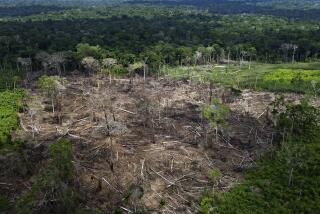Dead Trees Standing
- Share via
SANTA BARBARA — When Vice President Dick Cheney recently proposed that we look to nuclear power to ease the energy crunch, I thought about a little-known, curious experiment conducted in the 1960s and ‘70s at Brookhaven National Laboratory on Long Island. During the Cold War, the danger of a nuclear war or the accidental release of radioactive materials seemed real. To examine the effects of radiation on natural ecosystems, the federal government sponsored experiments. At Brookhaven, scientists irradiated an entire forest.
I was one of the researchers in this forest of dead trees standing. The forest looked as if it had just burned the day before, though the trees had actually been dead for years. We could work in the forest up to four hours a day because the radiation used, cesium’s radioactive isotope 137, was relatively ‘clean’: Only gamma rays were produced. The laboratory had moved the largest source of cesium 137 that could be safely handled by earth-moving machinery into the forest and mounted it on a vertical, movable pole. The pole had devices that lowered the radioactive material into the ground, where lead shields provided the protection for researchers.
A journey to the center of the forest--that is, the source of radiation--after a decade of exposure was surreal. The forest was enclosed by two chain-link fences with locked gates. Just inside the fences, the woods were typical of those found on Long Island: a dense clutch of small pitch pines, scarlet and white oaks, and small shrubs, mostly blueberry and huckleberry. Many plants were quite fragrant. The sounds of crickets and cicadas filled the air. Ovenbirds called. My walk toward the source began as a pleasant stroll through the woods.
As I moved closer, more and more pine trees had dead branches and needles. Farther on, all the pines were dead, but many were still standing. Some of the fallen pine trunks were beginning to rot--the bacteria and fungi of decay had survived the radiation.
Up ahead, the white oaks looked sick. Soon, they, too, were all dead--and standing. The scarlet oaks proved to be the hardiest of the trees. As I neared the source, I saw some survivors.
It was like walking up a mountain. The higher up you climb, the smaller and fewer the trees. Eventually, the trees drop out completely and you reach a zone of low shrubs, then a tundra zone of smaller ground plants and, finally, if the mountain is high enough, no life at all.
So it was in the irradiated forest. Blueberries and huckleberries survived the trees, growing among grasses and sedges. Closer to the source, only a patchy cover of sedges. Then you came upon perfect triangles of sedges--green, grass-like, flowering plants--growing behind the trunks of standing dead trees. Just as they do with sunlight, the trunks shaded the sedges from the radiation. It was an eerie demonstration of how light rays travel.
Near ground zero, all plants were dead, but they had not decayed. The radiation had killed off the armies of decay: fungus, bacteria, earthworms, etc.
I hunted around for any signs of life. Within about six feet of the source, I found, on the back of a sign warning of the radiation danger, a small green patch of the algae Protococcus. The algae grows on damp soils. The sandy soil encircling the source was tinted gray, the color of the dead leaves and twigs that had not decayed.
From the air, the forest was an eerily beautiful sight of death radiating outward. You could see the tower containing the radiation, surrounded by a lifeless, gray-tan zone. Then came a circular ring of sedges, one of shrubs, another of oaks without pines and then the healthy forest. Rather than the intricate mosaic of life forms that characterizes normal forests, the one at Brookhaven was a series of concentric circles signifying the stages of death by radiation.
The radioactive waste generated at nuclear power plants can create similar landscapes. One idea is to bury it. But the radioactive materials remain dangerous for 10,000 years. A government task force assigned the job of designing a warning system that could be understood by people living 100 centuries from now came up with the idea of constructing solid structures above the waste depository that would emit mournful sounds when the wind blows.
The irradiated forest at Brookhaven National Laboratory is mournful indeed. The forest and the problems associated with the transportation and storage of nuclear wastes are also a mournful prospect, one that should make us pause and think carefully before we move in the direction of greater emphasis on nuclear power rather than on energy sources that are more environmentally benign.
More to Read
Sign up for Essential California
The most important California stories and recommendations in your inbox every morning.
You may occasionally receive promotional content from the Los Angeles Times.













